|

 Up
Up 
 Wright Engines
Wright Engines

(You are here.)



  Need
to Need
to
find your
bearings?
Try
these
navigation aids:
If
this is your first
visit, please stop by:
Something
to share?
Please:



|
|
Available in Française, Español, Português, Deutsch, Россию,
中文,
日本, and others.
 he
Wrights produced approximately 200 gasoline-powered engines for their
airplanes. These fall into three basic types: he
Wrights produced approximately 200 gasoline-powered engines for their
airplanes. These fall into three basic types:
- The horizontal 4-cylinder engine produced from 1903
to1905
- The vertical 4-cylinder engine produced from
1906 to 1912
- The vertical 6-cylinder engine produced from 1911 to 1916.
They also built two unique "one-off" engines. In 1910, the Wrights produced an experimental V-8 engine for
one of their 1910 Model R racing airplanes. It was actually a variant of their vertical 4-cylinder
engine. And in 1901, before they made any of their aircraft engines,
they first built a single-cylinder natural gas engine to power their
shop tools.
The
Wrights designed all of their motors, but machinist Charles Taylor built them,
beginning with the 1901 shop engine. He supervised the engine manufacturing after the company started in 1909
and continued
until he left in 1911 to assist Cal Rodgers as he flew a
Wright Model EX, dubbed the
Vin
Fiz, across America. Although the Wright motors had many novel features, the
Wright brothers
regarded the motor as an accessory, and never applied for a patent on any motor or
improvement. Hobbs described this as "the essentially perfect engineering achievement
by the classic definition...And the overall record of their power plants shows them to have
been remarkably reliable in view of the state of internal combustion engine at that
time."
References:
- Hobbs, Leonard S. The Wright Brothers' Engines and Their design. Washington, D.C.:
Smithsonian Institution Press, 1971, p 61, 63, 68.
- McFarland, Marvin W. (ed) The papers of Wilbur and Orville Wright. McGraw-Hill Book Co.,
New York, 1953, pp 1210-1217.
- Taylor, Charles E. "My Story of the Wright Brothers, as told to Robert S.
Ball." Collier's Weekly, Dec. 25, 1948, 27, 68, 70.
[Submitted by Joe W. McDaniel]
|
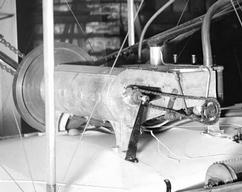
The 1903 horizontal 4-cylinder engine installed in the
Wright
Flyer I.
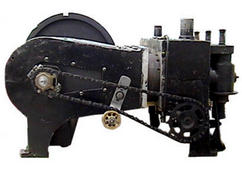
In 1904, the Wrights built a horizontal 4-cylinder "bench engine" to
run propeller experiments. This also served as a test bed for new
ideas to improve engine performance.
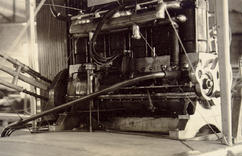
A Wright vertical 6-cylinder engine -- Wright 6-60
– installed
in the Wright Model C Flyer.
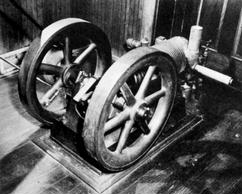
In 1901, just as they were beginning their aviation career, the
Wrights built a shop engine that ran on natural gas. This engine
powered the metal lathe, drill press, and other machine tools the
Wrights needed to build their first aircraft engines.
|
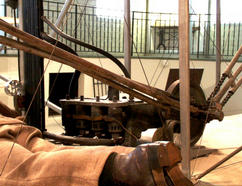
A slightly larger and more powerful horizontal 4-cylinder engine was
used in the
Wright Flyers II and
III in 1904
and 1905.
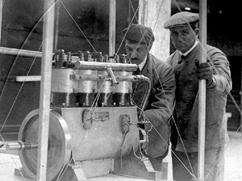
French workmen install a Wright vertical 4-cylinder
engine – a Wright 4-40 -- in a
Wright Model A Flyer.
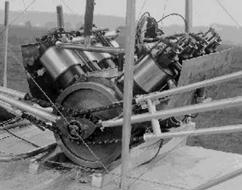
The Wright 8-cylinder V-8 racing engine installed in the
Wright
Model R. Only one of these engines was ever built. |